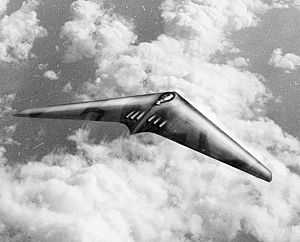Horten H.XVIII
| H.XVIII | |
|---|---|
 | |
| Role | Long-range bomber |
| National origin | Germany |
| Designer | Walter and Reimar Horten |
|
| |
The Horten H.XVIII was a proposed German World War II flying wing intercontinental bomber that would have been based upon the Horten Ho 229 design. Like the Ho 229, it would have possessed similar stealth characteristics, as well as a large fuel capacity for transatlantic missions. Based on data from the 229 design, experts at Northrop Grumman who built a replica 229 from the original plans in order to test its stealth capability have estimated the H.XVIII would have been able to (in ideal conditions) evade radar detection until it was within eight minutes of the east coast of the United States, making allied interception prior to payload delivery highly unlikely.[1] However, given the abilities of the allies to decode Enigma machine messages, it is questionable whether such a mission could be planned or launched without their knowledge. Once that happened, simple countermeasures (such as high altitude Combat Air Patrol (CAP) over United States targets, or better radar, or bombing during construction) might reduce the ability of the Horten H.XVIII to achieve its objectives.
Development and design
H.XVIIIA
The A model of the H.XVIII was a long, smooth blended wing body. Its six turbojet engines were buried deep in the wing and the exhausts centered on the trailing end. Resembling the Horten Ho 229 flying wing fighter there were many odd features that distinguished this aircraft; the jettisonable landing gear[2] and the wing made of wood and carbon based glue, are but two. The aircraft was first proposed for the Amerika Bomber project and was personally reviewed by Hermann Göring, after review, the Horten brothers (with deep dissatisfaction) were forced to share design and construction of the aircraft with Junkers and Messerschmitt engineers, who wanted to add a single rudder fin as well as suggesting underwing pods to house the engines and landing gear.[1]
H.XVIIIB
The B model of the H.XVIIIB was generally the same as the A model, except the four (down from six) engines and four-wheel retractable landing gear were now housed in underwing pods, and the three-man crew housed under a bubble canopy. The aircraft was to be built in huge concrete hangars and operate off long runways with construction due to start in autumn 1945, but the end of the war came with no progress made. Armament was considered unnecessary due to the expected high performance.[1]
H.XVIIIC/B-2
The C model of the H.XVIII was based on the airframe of the H.XVIIIA with a huge tail. It had an MG 151 turret set in the middle rear of the wing and with six BMW 003 turbojets slung under the wings; this was designed by Messerschmitt and Junkers engineers. It is uncertain if this overall design was directly developed by the Horten brothers or their manufacturer, as there is little surviving evidence of this proposed version. It was eventually rejected by the Horten brothers, as it was not a major improvement over the Ho XVIIIA.
Similar aircraft
Specifications (H.XVIIIA)
Data from [3]
General characteristics
- Crew: 3
- Wingspan: 40 m (131 ft 3 in)
- Wing area: 150 m2 (1,600 sq ft)
- Aspect ratio: 10.7
- Empty weight: 11,000 kg (24,251 lb)
- Max takeoff weight: 32,000 kg (70,548 lb)
- Fuel capacity: 16,000 kg (35,274 lb)
- Leading edge sweepback: 24.3
- Aerofoil thickness: 16%
- Powerplant: 6 × Junkers Jumo 109-004 turbojet engines, 8.8 kN (2,000 lbf) thrust each
Performance
- Maximum speed: 820 km/h (510 mph; 443 kn)
- Cruising speed: 750 km/h (466 mph; 405 kn)
- Never exceed speed: 900 km/h (559 mph; 486 kn)
- Towing speed: 192 km/h (119 mph)
- Landing speed: 136 km/h (85 mph)
- Wing loading: 213 kg/m2 (44 lb/sq ft)
- Thrust/weight: 0.00165 kN/kg (0.17 lbf/lb)
Armament
- Bombs: 700 kg (1,543 lb) of bombs
References
Notes
Bibliography
- Horten, Reimar and Peter F. Selinger. Nürflugel (in German). Graz, Germany: H. Wieshaupt Verlag, 1985, pp. 165–167. ISBN 3-900310-09-2.
- Myhra, David. The Horten Brothers and Their All-Wing Aircraft. Atglen PA: Schiffer Publishing Ltd., 1998. ISBN 0-7643-0441-0.
External links
| Wikimedia Commons has media related to Horten H.XVIII. |
- Luft '46
- Nurflugel.com
- National Geographic Special – "Hitler's Stealth Fighter" – with extensive videos, photos, and archival footage.
| ||||||
| ||||||||||||||||||||||